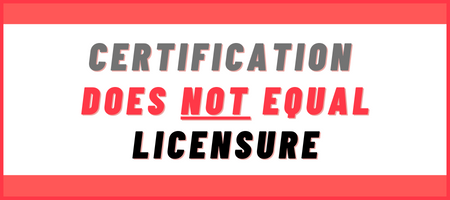Problems in the Post Op Recovery Industry

An Industry Divided: The Confusing Part About Post Op Massage
There are a lot of terms thrown around regarding a person’s qualifications to work on people who are post-op, and it is hard to tell what they really mean – even for licensed therapists. Imagine how clients feel trying to figure out who to see after plastic surgery for their massages.
Let’s take a look at the different variety of people working in the post-op realm to better understand where this course fits in the mix, and why you should take it if you are a Licensed Massage Therapist who is already Manual Lymphatic Drainage Certified.
Licensure vs. Certification:
A VERY Important Distinction
Before I talk about the different segments of the post-op market for plastic surgery recovery, I want to be very clear about the fact that most states require what is called “a license to touch” in order to work on people’s bodies.
Who has a “license to touch?” Massage therapists, physical therapists, occupational therapists, nurses, doctors, and similar licensed health care professionals may touch another person to deliver a type of therapy. The key word here is “license.”
Licenses are regulated by the individual states who have laws and governing boards that ensure a person petitioning to obtain that license have met the legal requirements to hold that license. Here is a list of what each state requires in terms of massage licensing. To be clear, a professional license is something totally different than a business license which is usually issued by the city in which a person opens a business.

A commonly thrown around term in the post op recovery industry is “certification.” A certification is basically a piece of paper that shows someone completed a course or series of courses. Certifications are quite common in the massage world for continuing education. For example, some Licensed Massage Therapists (LMT’s) may want to be certified in medical massage. So, they attend a training developed by someone and they receive a certificate upon successful completion of the training that allows them to claim that they are a certified massage therapist in myofascial work.
The Unregulated (For Now) Practitioners: “Body Contourists” & “Body Sculptors”
Body Contouring or Body Sculpting is a completely unregulated industry that has recently made its debut. Because it is so new, state licensing agencies have not yet developed standards for licensure for people who choose to use these terms for what they do.
There are people who sell courses to literally anyone who wants to sign up – anyone. You could be an English professor, a truck driver, a fast food employee, or a retail worker with zero knowledge of the human body (anatomy and physiology), zero knowledge of communicable diseases of the skin or bodily fluids, zero knowledge of sanitation protocols, or any such background. You take a course that lasts a couple of hours, and Ta-Da! You’re now a “certified” body contourist.
Nevermind that the fact that you don’t have any of the aforementioned skills that ensure the safety of the public. These courses usually take massage therapists 500-750 hours on average to complete in order to be licensed – in several states, even more than that.
Body Contour training is big business. The people offering the training are in it solely for the money. They do not care that they are setting up newly minted practitioners for potential lawsuits when they cause harm to their clients.
The Body Contouring Training Industry as a whole could not be less concerned about the welfare of the students it issues certificates to, or the health of the unknowing people that come to them. The general public does not understand that some people operate without a professional license.
Below is an example taken from the FAQ section of a popular Body Contouring training website. This is not meant to call out this business in particular. It is just pretty much par for the course. No license, No pre-requisites, No exams, NO PROBLEM! Just give us your money and we will give you a worthless piece of paper saying you are “certified” to perform procedures on the unsuspecting public. (!?!?!?)



Personally, I find it particularly disturbing that in the above example they believe in treating their “students as professionals,” so they “do not require exams,” when their students aren’t actual professionals that have passed exams in the past to get licensed.

How I feel most days because of what I hear about what untrained therapists have done to my clients.
It Gets Worse. Much, Much Worse.
It’s bad enough that people are being duped into taking training that can get them into legal trouble when they are caught operating without a professional license to touch.
What is worse is that certain body contouring “schools” go far beyond the typical radio frequency, cavitation, and wood therapy that is taught with most of these schools. Generally, body contouring is referred to as “non-invasive” therapies, which is debatable because they impact the skin, fat, and fascia – usually in damaging ways. But where the rubber really meets the road is when they start teaching something called “incisional drainage.”
Incisional Drainage vs. Manual Lymphatic Drainage
They are NOT the Same
Incisional Drainage is a very illegal and brutal technique for getting free-floating fluid out of the body after plastic surgery by reopening incisions and pushing the fluid with great force until it exits the holes in the skin. It is illegal for massage therapists to work on wounds like surgical incisions, and even nurses who work in wound care generally receive additional training specifically for the purpose of ensuring patient safety.
Yet, this is being done by people who have zero license and zero legitimate training in anatomy and physiology. They often call themselves “Body Contourists” which is an unregulated industry. Despite being unregulated as an industry, in most states these “contourists” are violating the law by not having a license to touch as was mentioned earlier.
This practice originated in South America, made its way through the Caribbean, and finally landed in Miami. From Miami it has spread like wildfire across the US. It is said that Incisional Drainage was called “Lymphatic Drainage” in the Caribbean, and it carried that name with it to the US. This is unfortunate because the practitioners who teach others to perform this practice mistakenly call it Lymphatic Drainage or Lymphatic Drainage Massage.
True Lymphatic Drainage actually came from Europe nearly 100 years ago. Dr. Emil Vodder and his wife Dr. Estrid Vodder were the first people to develop a technique to move lymph back in the early part of the 20th century. In 1936, Dr. Vodder introduced a technique that he called “Manual Lymphatic Drainage” at a medical conference in Paris. This therapeutic technique was a very gentle sequence of skin stretches that opened the lymphatic capillaries to allow fluid from the tissues to enter the lymphatic system and be transported back to the bloodstream where it is then eliminated via urination.
The End Result
The end result of these unethical trainers is an industry that is overrun with potential dangers for clients.
This article Dirty Little Secrets About the Plastic Surgery Recovery Industry outlines the problem at hand in great detail. It shows news reports of dangerous therapies and has links to videos of various well-trained therapists speaking out about what real lymphatic massage is
Side note: If you are MLD trained and just read the last line and thought to yourself “how can she dare to call it ‘lymphatic massage,'” yes, there is a reason I use this term instead of MLD or Manual Lymphatic Drainage. Since the term “drainage” is a loaded one that could be interpreted as incisional drainage and because of the fact that in the post op recovery world, the term “lymphatic massage” is what is used I have conformed to meet my clientele where they are at rather than trying to get the whole world to understand appropriate terminology.
Why Does This Happen?
The plastic surgery industry is made up of some really good surgeons, some mediocre / average surgeons, and some very shady surgeons. For example, this article outlines several clinics in Miami, Florida where multiple people have died or nearly died. Upon investigation it was found that one of the clinics referenced was run by felons. At another clinic internal organs were punctured (plastic surgery of this nature should never get anywhere near internal organs), and the list goes on.
So, if a highly regulated profession like surgery can have commonly this caliber of plastic surgeons still holding licenses and performing sloppy surgeries, you had better believe that the advice that they give their patients is equally crappy. Many (if not most) surgeons in the Miami area knowingly send their patients to get incisional drainage procedures done.
Sadly, these doctors often do not actually know the difference between Manual Lymphatic Drainage (lymphatic massage) and Incisional Drainage.
Why Don’t They Know?
Doctors, on average, get about 30 minutes of training in the lymphatic system in all of medical school. You heard me – 30 minutes in TOTAL in four years of medical school. It’s not just my opinion. Not only have I been told by physicians on my own table, but you can find medical journal articles talking about it – like this one by Dr. Stanley Rockson, the Professor and Chief of Consultative Cardiology and the Director of the Stanford Center for Lymphatic and Venous Disorders at Stanford University.
By comparison, the introductory course I took in lymphatics was 16 hours. An MLD certification is 40 hours, and to become a Certified Lymphedema Therapist like me – that’s 135 hours – before you do continuing education and attend conferences, etc.
So, why do doctors send their patients to get incisional drainage that is mistakenly and confusingly referred to as “lymphatic massage” when it puts their patients at risk? Usually, they don’t know any better. Not only do they not understand the lapse in correct terminology, they have no idea of the difference in technique, training, or licensure.
Clearly, changes to medical school curriculum need to be made, but for now, this is where we are, and it is important to know this information if you are looking to get into the post op recovery industry. Your daily experience will be inundated with stories from your clients about their usually terrible experiences when they went to Miami, Tijuana, Juarez, the Dominican Republic, etc.
Don’t get me wrong. I’m not bashing on doctors in general – rather, I’m making a commentary about the lack of training that exists in the medical school curriculum on lymphatics.
Doctors have TONS of knowledge – especially surgeons. Their jobs are incredibly difficult and their training is long and challenging. I would never presume to know how to do what they do. Believe me! I’ve sat in on some plastic surgeries and it is truly remarkable what they can do. In that regard, they have my utmost respect.
That being said, I’d humbly offer the suggestion that they consider getting some CME’s (their continuing ed classes) in lymphatics since it is so incredibly important for them to have this knowledge. Without it, they put their patients at great risk by referring their patients to unqualified lymphatic therapists. With good knowledge of lymphatics they can help steer their patients to good, qualified therapists who are properly trained, licensed, and insured.
Do You Want to Be Among the Best Trained Therapists in Post Op Recovery for Plastic Surgery?
If you want to be the best of the best and you want to be confident in your work right out of training instead of figuring all of this stuff out over the course of years via trial and error, this class is for you!
Sign up here.

